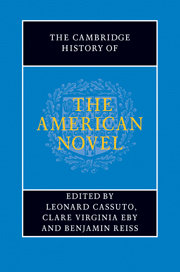Book contents
- Frontmatter
- General Introduction
- PART ONE INVENTING THE AMERICAN NOVEL
- Introduction: inventing the American novel
- 1 Transatlantic currents and the invention of the American novel
- 2 Susanna Rowson, Hannah Webster Foster, and the seduction novel in the early US
- 3 Charles Brockden Brown and the novels of the early republic
- 4 The novel in the antebellum book market
- 5 American land, American landscape, American novels
- 6 Cooper and the idea of the Indian
- 7 The nineteenth-century historical novel
- 8 Hawthorne and the aesthetics of American romance
- 9 Melville and the novel of the sea
- 10 Religion and the nineteenth-century American novel
- 11 Manhood and the early American novel
- 12 Sentimentalism
- 13 Supernatural novels
- 14 Imagining the South
- 15 Stowe, race, and the antebellum American novel
- 16 The early African American novel
- PART TWO REALISM, PROTEST, ACCOMMODATION
- PART THREE MODERNISM AND BEYOND
- PART FOUR CONTEMPORARY FORMATIONS
- A selected bibliography
- Index
4 - The novel in the antebellum book market
from PART ONE - INVENTING THE AMERICAN NOVEL
Published online by Cambridge University Press: 28 July 2011
- Frontmatter
- General Introduction
- PART ONE INVENTING THE AMERICAN NOVEL
- Introduction: inventing the American novel
- 1 Transatlantic currents and the invention of the American novel
- 2 Susanna Rowson, Hannah Webster Foster, and the seduction novel in the early US
- 3 Charles Brockden Brown and the novels of the early republic
- 4 The novel in the antebellum book market
- 5 American land, American landscape, American novels
- 6 Cooper and the idea of the Indian
- 7 The nineteenth-century historical novel
- 8 Hawthorne and the aesthetics of American romance
- 9 Melville and the novel of the sea
- 10 Religion and the nineteenth-century American novel
- 11 Manhood and the early American novel
- 12 Sentimentalism
- 13 Supernatural novels
- 14 Imagining the South
- 15 Stowe, race, and the antebellum American novel
- 16 The early African American novel
- PART TWO REALISM, PROTEST, ACCOMMODATION
- PART THREE MODERNISM AND BEYOND
- PART FOUR CONTEMPORARY FORMATIONS
- A selected bibliography
- Index
Summary
The market for antebellum American novels has yet to be materially considered within its broader socio-cultural field. Their production, distribution, and consumption have been too often distorted by scholarly focus on the canon, non-canonical influences upon it, and, in rare cases, a few bestsellers or obscure imprints that shed light on social issues, then and now. Overlooked are entrepreneurs like Boston's Frederick Gleason, who produced more first-edition American-authored titles than anyone, even Harper and Brothers. Gleason specialized in short pamphlets between 60 and 120 pages, while Harper and Brothers issued mostly hardcovers, the format of canonical works. The well-remembered Harpers' road led to “serious literature,” and the forgotten Gleason paved the way to cheap popular literature. The two roads were mere exploratory paths within the publishing landscape compared with longstanding highways filled with standard works, religious propaganda, schoolbooks, business ephemera, partisan newspapers, and reference material. Still, these pathfinders of American novel publishing set the direction for future longer-length American fictional ventures in print and other media.
This discussion follows novels through their production, distribution, and consumption. Beginning in the 1820s, entrepreneurial publishers nurturing their own house lists gambled to an unprecedented degree on Americanauthored novels, as they issued nearly five times as many titles as in the previous decade. Prior to that, such novels as Susanna Rowson's Charlotte Temple (1794) or Charles Brockden Brown's Wieland (1798) represented highly unusual speculations by their locally oriented publishers, who not surprisingly paid their authors very little, if anything at all.
- Type
- Chapter
- Information
- The Cambridge History of the American Novel , pp. 67 - 87Publisher: Cambridge University PressPrint publication year: 2011
- 3
- Cited by



